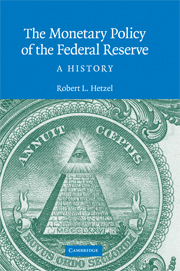Book contents
- Frontmatter
- Contents
- Figures
- Preface
- 1 The Pragmatic Evolution of the Monetary Standard
- 2 Learning and Policy Ambiguity
- 3 From Gold to Fiat Money
- 4 From World War II to the Accord
- 5 Martin and Lean-against-the-Wind
- 6 Inflation Is a Nonmonetary Phenomenon
- 7 The Start of the Great Inflation
- 8 Arthur Burns and Richard Nixon
- 9 Bretton Woods
- 10 Policy in the Ford Administration
- 11 Carter, Burns, and Miller
- 12 The Political Economy of Inflation
- 13 The Volcker Disinflation
- 14 Monetary Policy after the Disinflation
- 15 Greenspan's Move to Price Stability
- 16 International Bailouts and Moral Hazard
- 17 Monetary Policy Becomes Expansionary
- 18 Departing from the Standard Procedures
- 19 Boom and Bust: 1997 to 2001
- 20 Backing Off from Price Stability
- 21 The Volcker–Greenspan Regime
- 22 The Fed: Inflation Fighter or Inflation Creator?
- 23 The Stop–Go Laboratory
- 24 Stop–Go and Interest Rate Inertia
- 25 Monetary Nonneutrality in the Stop–Go Era
- 26 A Century of Monetary Experiments
- Appendix: Data Seen by FOMC for the Stop–Go Period Shown in Figures 24.1, 24.2, and 24.3
- Notes
- Bibliography
- Index
- Titles in the series
17 - Monetary Policy Becomes Expansionary
Published online by Cambridge University Press: 26 May 2010
- Frontmatter
- Contents
- Figures
- Preface
- 1 The Pragmatic Evolution of the Monetary Standard
- 2 Learning and Policy Ambiguity
- 3 From Gold to Fiat Money
- 4 From World War II to the Accord
- 5 Martin and Lean-against-the-Wind
- 6 Inflation Is a Nonmonetary Phenomenon
- 7 The Start of the Great Inflation
- 8 Arthur Burns and Richard Nixon
- 9 Bretton Woods
- 10 Policy in the Ford Administration
- 11 Carter, Burns, and Miller
- 12 The Political Economy of Inflation
- 13 The Volcker Disinflation
- 14 Monetary Policy after the Disinflation
- 15 Greenspan's Move to Price Stability
- 16 International Bailouts and Moral Hazard
- 17 Monetary Policy Becomes Expansionary
- 18 Departing from the Standard Procedures
- 19 Boom and Bust: 1997 to 2001
- 20 Backing Off from Price Stability
- 21 The Volcker–Greenspan Regime
- 22 The Fed: Inflation Fighter or Inflation Creator?
- 23 The Stop–Go Laboratory
- 24 Stop–Go and Interest Rate Inertia
- 25 Monetary Nonneutrality in the Stop–Go Era
- 26 A Century of Monetary Experiments
- Appendix: Data Seen by FOMC for the Stop–Go Period Shown in Figures 24.1, 24.2, and 24.3
- Notes
- Bibliography
- Index
- Titles in the series
Summary
Credibility allowed the FOMC to run an expansionary monetary policy in response to the international economic crises that started in summer 1997. Expansionary policy appeared initially as strong real growth not inflation.
The Fed's Response to Asia
In 1997, the FOMC debated how to reconcile strength in the economy and a falling unemployment rate with low inflation. At his July 1997 Humphrey–Hawkins testimony, Greenspan talked of a “new paradigm” where technological growth would keep capacity in line with increased demand. However, he added that growth in employment could not indefinitely exceed growth of the labor force. By fall, the unemployment rate had fallen to 4.8%. In October 1997, a hawkish Greenspan (December 1997, 965) warned Congress: “The law of supply and demand has not been repealed. … Short of a marked slowing in the demand for goods and services … the imbalance between the growth in labor demand and expansion of potential labor supply … must eventually erode the current state of inflation quiescence.”
Markets assumed that the FOMC was ready to raise the funds rate. Subsequently, the Asia crisis emerged. Although a rate hike had appeared likely at the November FOMC meeting, stock market volatility intervened. Concern over weakness in Asian equity markets produced a fall of 554 points in the DJIA on October 27, 1997. Added to the declines of the two prior days, the index fell 10.9%. Asia then came to dominate policy.
- Type
- Chapter
- Information
- The Monetary Policy of the Federal ReserveA History, pp. 218 - 226Publisher: Cambridge University PressPrint publication year: 2008

